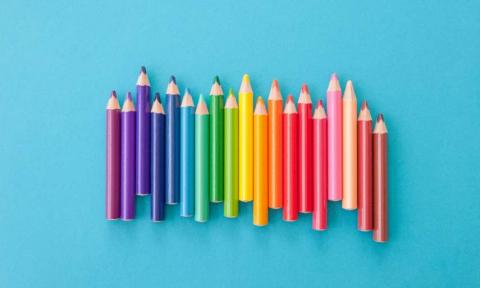
Educators ensure LGBTQ-inclusion is taught in their classrooms
The GLSEN Day of Silence is a national day of action where LGBTQ students and educators across the country—and the world—take a vow of silence to protest the harmful effects of silencing LGBTQ people in schools. Educators can support these efforts by actively teaching about LGBTQ people, identity, historical events and themes.
See how these educators are “breaking the silence” of hidden curriculum in their classrooms and GSAs:
Blair Parker, she/her/hers: I teach 11th grade American Studies in Bronx, NY. I ask my students to examine the inclusion, exclusion, and leadership of queer Americans in twentieth century social movements. My course ends with all of my students acting out scenes from Angels in America.
Chelsea Ruede, they/them: I teach 8th grade Language Arts in Seattle, Washington. I teach about LGBTQIA+ people, identities, and themes by actively naming my own queer and trans identities and never making invisible the myriad ways in which I perform my queerness, from the love of gesticulation to letting my chin hairs grow long and my voice crack unashamed. From a content perspective, we name and center queer authors and stories and take a queer lens when critiquing other work. Students must see themselves in the curriculum and classroom, and I am happy to be visible and thriving for them.
Karen Natorp-Anderson, she/her/hers. I teach an 11th grade Topics in United States History || Seattle, WA. This semester long course examines United States History through the lens of gender and sexuality. Two central themes of the course are: the dynamism of cultural and social norms and the quest for equal rights. While it is not always accurate or fair to label historic figures with contemporary terminology and identities, we use case studies to reveal gender and sexual diversity - from 19th century bromances and 'smashes' to the Mattachine Society and Daughters of Bilitis - before doing a deep dive on liberation movements from the late 1960s to the present.
Dylan Kapit, they/them theirs: I teach elementary special education. For me, LGBTQ+ inclusive education mostly has to do with language and explicit instruction. Using the words “students” or “friends” instead of gendered language like “boys and girls”, having visuals around the classroom of diverse people, making sure that word problems in math familiarize gender neutral pronouns and different types of families and relationships, etc. Even seemingly simple actions like this makes a huge difference for young students. Additionally, explicit instruction about LGBTQ+ identities in a developmentally appropriate way so that students understand the diversity in the world is important. Elementary aged students and students with disabilities deserve information about these communities just like everyone else, it just needs to be done in a way that makes sense to them.
Natalie Clifford (she / her / hers): I teach English to Speakers of Other Languages (ESOL) to newcomer immigrant youth in San Antonio, Texas. I teach LGBTQ+ people, identities, and themes through centering identity and structures of power as an honest, integral foundation of our conversations every day in class. The students and I constantly take time to reflect on our own identities and how those connect to larger issues of power, privilege, and oppression. The most important aspect of our classroom community is that we are all always learning, including myself, which gives space to unlearn and grow every day.
Max Monegan, he/him/his, I taught 10th grade American History in Northeast Ohio. I included queer historical figures that are often already discussed in the curriculum - such as Alan Turing and Bayard Rustin - whoes queer identies are often erased, as well as discussing the narrowing definitions of masculinity and feminity across the 20th century and how those narrowing definitions, along with the medicalization of homosexuality, resulted in the creation of new forms of identity, as well as new ways of understanding gender, sexuality, and the ways in which we understand them as seperate-yet-related.
Maya Suzuki Daniels, She/her/hers, I teach 10th and 11th grade English in San Pedro, California. I practice my allyship by ensuring that our class and school libraries have books centering LGBTQIA+ characters, and requiring that students read a book by an LGBTQIA+ author as part of their independent reading projects. Per our district mandate, I also incorporate LGBTQIA+ leaders and events into our projects and curriculum. As an educator, I've watched a lot of my colleagues turn this work over to their LGBTQ-identified peers. While I cannot overstate the necessity of their leadership, educational justice involves all of us addressing and normalizing different identities and orientations.
Clark Hoelscher, they/them/theirs: I taught high school science courses including biology, physics, epidemiology, climate science, and reproductive biology. In all of my courses, LGBTQ+ inclusive and affirming instruction meant sharing representation of the full lives of scientists including Alan Turing and Rachel Carlson. In my courses, we directly confronted misconceptions about sex and gender including the idea that there were only two sexes. Our learning together made the impact of human bias on scientific outcomes visible, for instance critically examining how bias against LGBTQ+ people impacted our public health generally at the beginning of the HIV pandemic.
Use our Inclusive Curriculum Guide to see how you can break the silence of your curriculum and create more inclusive and affirming learning environments, this Day of Silence and beyond!
